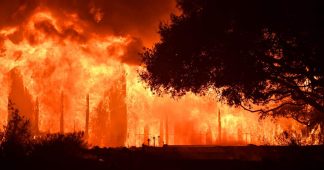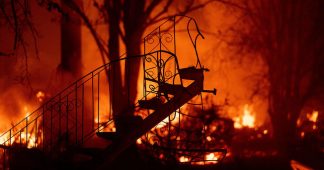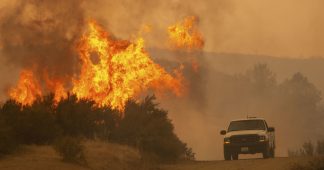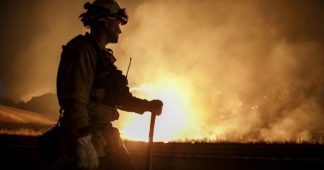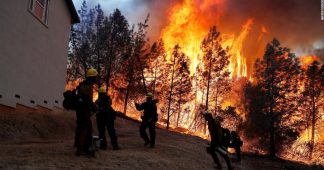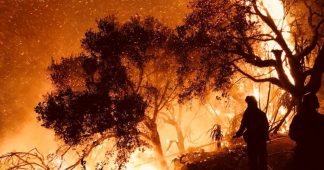Growing outrage over PG&E role in California fire disaster
By Gabriel Black
30 October 2019
Fires continued throughout California Tuesday, with hundreds of thousands evacuated and many more without power. Calmer winds prevented the most significant fires—the 75,000-acre Kincade fire north of San Francisco and the smaller, but more urban, Getty fire in Los Angeles—from growing substantially. At the time of this writing, officials warn that an intense rise in winds Tuesday night and Wednesday could reverse this—leading to a resurgence of the over fifteen fires currently burning, and potentially causing new ones.
Pacific Gas and Electric Company (PG&E) is one of the regional utility monopolies that dominate the state and extract billions of dollars each year in profits. Along with Southern California Edison and San Diego Gas & Electric, PG&E has been shutting off electricity to entire regions of the state affecting some 3 million people.
The World Socialist Website spoke to students and workers across the state who are outraged by how regular these devastating fires have become.
Steve, a teacher from Santa Cruz , described how his hometown had become a “ghost town,” There is “no work for most of us, no traffic lights, no water, just darkness.” He asked, “Why do we have to pay for the mistakes and lack of foresight on the part of PG&E? PG&E is a private utility company and can tell you what to do and you have to pay them money. There are no infrastructure modifications being done and considered.”
Jazmin, a graduate student at UC Berkeley, who is an expert on PG&E negligence and was previously interviewed by the WSWS, said, “At this time most of my family in the North Bay has been displaced as homes are threatened by the fast-moving flames.” Preoccupied with helping her family, she said, “I am not in a place to make an intellectual argument as to why the electrical monopoly isn’t suited for handling our power sources… I also think one isn’t needed. Just look at where we are and all of the devastation their mismanagement has brought.”
Masha, a hotel worker from Mill Valley, told the WSWS, “Being without power for a short period of time isn’t really the hard part. It’s more the fact that you don’t know how long it will be. They say 24 to 48 hours but then they need to check all the lines and that can take another 12 to 24 hours apparently. They had a hard time checking the lines in time for the shut off that started on Saturday because of the smoke, so that shut off was more like 65 hours. I know they tell you to prepare for several days and most people were prepared physically but it’s more what it does with you mentally when you don’t know when your life will be back to normal. It also didn’t help that their website is never updated. I got all my updates from the local sheriff department and even they had a hard time getting accurate and timely information.”
“Personally, it’s scary,” she continued “our little one was scared in the pitch black and it was hard to keep him warm at night. The hotel I work at lost revenue for 3 full days that had been almost sold out. Not to mention all the restaurants and super markets that had to toss all their perishable foods.”
James, a retired teacher living in Berkeley, described how the power cuts affected his family. “Our power went out on Saturday evening and was restored on Monday at 4 PM. PG&E has warned that power will probably be cut on Tuesday and not be restored for several days. Unlike nearly 200,000 people further north, we did not have to evacuate, but the cut-off was disruptive. We lost computer connections, internet, and e-mail, all of which hampered work. News was harder to get. Loss of refrigeration meant all frozen food melted and much other food in the refrigerator is questionable. The microwave oven, washing machine, coffee maker, etc. did not work. Planning meals was suddenly a lot more difficult than usual.”
He continued, “The unpredictability of when the next outage comes and how long it will last, is disconcerting. If it is prolonged, we will probably move in with relatives in unaffected areas, but there are no guarantees. Compared to people who lost their homes or had to evacuate, we have been much better off, but if, as PG&E is saying, this pattern of hard-to-predict cut-offs will be the ‘new normal’ for the next ten years, thoughts of how to deal with what is a systemic crisis are inescapable.”
Jamie, a writer from Alameda, expressed hostility to Democratic Governor Gavin Newsom’s response. “He’s like a used Porsche salesman!” Jamie connected the fire crisis to the broader social crisis. “The state is a mess. There are so many people living in boxes. Tents, shanties, cars and RV’s. It’s just amazingly sad. Feels like end times.”
The WSWS met Gemma, a Swiss immigrant at one of the refugee centers in Los Angeles. Speaking about the power cuts she said, “at first I thought ‘that’s smart,’ but really, that’s not smart! If you have to suddenly leave because of a fire and your fridge is down your internet and your phone is down, or not charged, you can’t bring food with you, you can’t contact people. I think it should have been handled differently.
“In Europe they put all the cables underground. Maybe some aren’t but the majority are underground… I think if they modernized, seriously did something about it, it would have to be at the state level, not just one company. That would change something I think.”
The three main regional monopolies have been responsible for over 2,000 wildfires in California since the state began requiring them to report incidents in 2014. PG&E alone is responsible for over 1,500 fires, including 16 major fires in 2017. Eleven of those sixteen were determined to involve PG&E negligence.
Larry, a bus driver in the Bay Area, also spoke to the WSWS. “My wife’s daughter and her family with a one-year old child had the power shut off Saturday night and came to stay with us Sunday morning. The baby is one year old and would have been quite cold and frightened to stay there.”
Published at https://www.wsws.org/en/articles/2019/10/30/fire-o30.html
